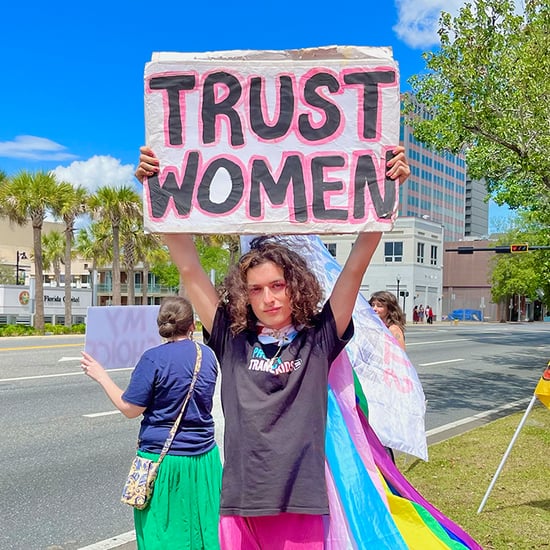
Problems With Ivanka Trump's Maternity Leave Proposal
Why We Should Pay Fathers to Take Time Off If We Want Gender Equality
Ivanka Trump has emerged as self-designated champion of working mothers. Her new book, Women Who Work, presents her personal blueprint for success at home and at work, yet it glosses over the advantages money affords her, like nannies and other paid help. "My father has always said, if you love what you do, and work really, really hard, you will succeed," she writes, implying that issues like inequality and poverty can be solved with a little passion and willpower.
During the presidential campaign, however, Ivanka Trump did address concrete policies for helping women who work. Specifically, she advocated for six weeks of paid maternity leave for birth mothers funded by federal unemployment insurance. Yet the proposals she discussed during the campaign wouldn't extend to gay parents, adoptive parents, or fathers.
While paid leave would be a crucial right for many new mothers, evidence from other countries suggests Ivanka Trump's initial proposal would fall short of achieving gender equality in the workplace and at home. In addition to being unfair for adoptive parents and men, such policies could also have unintended negative consequences for women. Because such a right would be exclusively extended to women, employers could become biased against all women of childbearing age during hiring, even those who do not intend to have children. After all, only women would have a right to leave with compensation and potentially cost the company more money. Wouldn't it just be safer to hire men? Such policies could also mean that women would continue to bear the burden of child care at home or even take on more.
Creating a system that incentivizes fathers to take paternity leave would counterintuitively benefit women. Countries have done this by designating use-it-or-lose-it time for each parent and making sure it's well paid. When fathers take more time off, it changes employers' attitudes about working women and men, gives mothers the support they need to go back to work, and increases men's participation in child care. If Ivanka Trump and other advocates for working mothers are serious about making a change to our thoroughly lacking family leave law, it's important they consider policies like these that get us closer to gender equality.
Something Definitely Needs to Be Done in America

Currently, the United States is the only developed country that does not offer some form of paid parental leave. In fact, fewer than five countries in the entire world fail to offer it. Others include Swaziland, Lesotho, and Papua New Guinea. Under the current federal law known as Family and Medical Leave Act (FMLA), American men and women are guaranteed 12 weeks of job protection and unpaid time off for qualifying medical and family reasons. Having a child is one of those. But if you can't afford to take 12 weeks off without compensation, the protection is worthless to you. A handful of US states provide some pregnancy-related disability time off for women after birth, and California, New Jersey, and Rhode Island offer an additional four to six weeks of partially paid time off to parents for bonding. Some businesses voluntarily offer paid leave, but according to a recent report, only 13 percent of private sector employees overall and six percent of low-wage workers have access to such benefits.
President Bill Clinton signed FMLA into law in 1993. During that time, even offering unpaid job protection was contentious, and many in the business community claimed it would be detrimental to the economy. But statistics show that FMLA has actually helped businesses by increasing employee retention, productivity, and morale.
Despite the positive impact, FMLA also has serious flaws. First of all, you have to work at the same company for 12 months to qualify, and it only applies to companies that have 50 or more employees. Because of that, one count found that only 54 percent of the US workforce was eligible for FMLA leave. And of course, the time off is unpaid, putting it out of reach for many who cannot afford it.

A 2015 study by In These Times found that one in four women return to work just two weeks after giving birth in the US. The article accompanying the study featured stories of women who had to choose between staying home to care for a baby and losing their jobs. Elementary school teacher Leigh Benrahou did not qualify for FMLA because her daughter was born prematurely. Despite planning conception around FMLA's rules, she fell short of the 12-month requirement when she went into early labor. Benrahou found herself going back to work less than two weeks after giving birth to avoid losing her job, even though she had a two-pound baby to care for. Natasha Long had to go back to her factory job three weeks after having a child and sat in her truck to pump breast milk during breaks.
The fact that the time off is unpaid also undermines FMLA's "gender neutral" language. Both men and women are entitled to the 12 weeks unpaid leave in the case of birth or adoption. That's great in theory, but some experts argue that the law actually helps ingrain the male-breadwinner model. In a paper comparing America's FMLA law to Iceland's law, Amanda Pesonen explained the consequences of FMLA:
"Because leave is unpaid, FMLA actually perpetuates the longstanding stereotype that a woman who takes family leave ought to have a male partner to support her financially while she is on unpaid leave. There is a longstanding perception in the United States that motherhood and employment are incompatible and, furthermore, that a man's proper role in the family is to serve as the breadwinner who compensates for his wife's lower earning potential, relegating him to a position of the secondary caregiver in the household."
Due to the current wage gap, it often makes more sense for the woman to take unpaid time off (in addition to the physical demands of caring for a new baby). This means that only she has to bear the associated costs to her career, which in turn could help fuel the wage gap even more.
Anu Partanen is a Finnish journalist and author of The Nordic Theory of Everything, which compares Nordic society to the American way of life. She explained America's lack of paid parental leave shocked her when she moved to the US from Finland. "American women battle the kinds of problems Nordic women know nothing of: pumping milk at work, feeling like a bad parent because they have to leave their baby at someone else’s care only a few months after giving birth, trying to work full time with an infant at home, and never getting enough sleep."
Partanen also said that lack of paid parental leaves means that American women are often stuck between two restrictive options: a supermom who wakes up every morning at 5 a.m. and never stops going and a stay-at-home mom. "In the Nordic countries, by contrast, parents can take a year off to care for their child while their job waits for them, and for either parent to abandon work entirely for parenting is seldom seen as necessary or even desirable." Partanen believes the support means parenting and working becomes a much more balanced and sane endeavor. "As a result, in all the Nordic countries, women over the age of 25 participate in the workforce at higher rates than women in the United States," she noted.
How Other Countries Incentivize Paternity Leave

If America is going to move toward a more progressive and humane approach to family leave, it should consider encouraging paternity leave as well. Countries across Europe, especially in Scandinavia, have done this by setting aside time off for both parents, with pay in line with their salaries.
"Most Nordic countries have launched special paid leave that is 'daddy-only' time off," explained Partanen, who spent a good amount of her book outlining research on the topic. "If the father doesn’t take advantage of this special chunk of leave, the family loses it." She noted that Iceland became famous for its so-called 3+3+3 model, in which a total of nine months of parental leave are divided into three equal blocks of three months each. "One of these blocks can be used by either parent, but of the two remaining blocks, one belongs to the mother and one to the father." If the father doesn’t take his personal allotment, the mother is not eligible to take it instead. In Sweden, Partanen noted, fathers get an exclusive three months, and in Finland the father’s personal share is nine weeks. And of course fathers can stay home even longer, if they choose to use part or all of the leave available to either parent.
Beginning in 2016, Iceland modified its 3+3+3 model to make it a 5+5+2 model. Each parent now has five months of use-it-or-lose-it paid time off and then two extra months either parent can use. The pay is typically 80 percent of your salary. It can be spread out over two years, but each period of leave must be at least two weeks. Parents can take it at the same time or separately. Single parents can take the full 12 months (which is otherwise split between the parents), and gay couples get the same rights as straight couples. In order to qualify, you have to have worked in the labor market (not for the same company) for six months.
In Iceland, about 90 percent of men take paternity leave. According to one study, the majority of Icelandic fathers who took it felt it helped them better understand their children's needs and feel more emotionally connected with their children. Other studies found that following the implementation of the law, marriage and childbirth no longer decreased a woman's interest in promotions — they were no longer "leaning out." Pesonen noted that Iceland regularly ranks number one on the Global Gender Gap Report and that the creation of an independent right to paternity leave is considered one of the largest steps it has taken toward equality.
In 2007, Germany updated its law with a creative solution: if both parents take at least two months of the available 10 months leave, the family gets a bonus two months of paid leave either parent can use. This encourages fathers to take at least two months away from their job to care for a new child. A study of initial outcomes found that even after a short leave, German fathers increased involvement in child care. And when they took more than two months, they also did more non-childcare housework.
Paternity Leave Leads to More Equality at Home
There Are Also Benefits For Women in the Workplace
Research finds that men in the US don't take available unpaid family leave for various reasons. They don't want to lose their typically larger income, worry about the social stigma, and are concerned about missing out on promotions. Countries that have adopted designated paid leave for both parents have helped address these issues for men, with the added benefit of more equality in the workplace for women. Because well-compensated use-it-or-lose-it time off has increased the number of men who take time off to care for children, it's now likely that either a man or a woman may miss work following the birth or adoption of a child. This may deter employers from discriminating against women of childbearing age, in turn helping future mothers and including women who don't plan to have children but may still be considered a "risk."
In addition, women can get more support from their partners when they return to work. A new mother may want to stay home for the baby's first months to breastfeed, recover from birth, or bond with a child. Thanks to policies that encourage paid paternity leave, the family may not have to deal with the stress and cost of finding a childcare option when she decides to return to work, since the father can take over without having to greatly sacrifice the family's income. This could lead to more participation from new mothers in the labor market and reduce the sacrifices women must make to their careers after starting a family.
"Part of the whole point of Nordic daddy-only leaves is that the right to such leaves is guaranteed for every single employee, making fathering an equally legitimate pursuit for all men," Partanen explained. "Employers and co-workers are much more willing to accept a man’s decision to stay home when they know that otherwise, his family would lose their right to that time and money."
The Potential Downsides
Paid family leave obviously has its opponents in America — or we'd join pretty much every other country in the world that provides it. A big concern is the cost to businesses and the government. Others worry that women will participate less in the labor market if they're compensated for taking time away from work. But that could be addressed by spreading the leave to men, too.
Luckily, we can look to states like New Jersey and California to see how this might play out. Both states have six weeks partially paid leave for each parent, which is funded by a small payroll tax. The Center for Women and Work at Rutgers looked into the effect of New Jersey's law and found that women who took paid leave were more likely to be working again after nine or 12 months after the birth than mothers who did not take paid leave. These women were also more likely to see an increase in wages in the future. While it only looked at shorter leaves, the study suggests that paid leave doesn't have a negative impact on a woman's earning or promotion potential. In fact, it has a positive impact.
In addition, the study's authors found a positive effect for businesses, which had to spend less on replacing employees. The government saw a benefit to the bottom line, too, since parents who took paid leave were less likely to need public assistance in the future. The study's authors recommended the US expand FMLA protections to include more workers and wage replacement.
The Nordic system also helps alleviate the financial burden from individual employers. Partanen explained: "Pay during a parental leave comes from an insurance fund that all employers and employees pay into, not only from that employee’s own employer." Some experts suggest that the US federal government could extend the already-existing Social Security program and create a fund dedicated to family leave. Of course the money has to come from somewhere, but lawmakers could reprioritize tax spending and cuts to make it happen.
Not everyone is convinced paid leave for either parent will accomplish more gender equality. Yana Gallen, an associate professor of public policy at the University of Chicago, said that paid maternity leave could encourage more mothers to work. That could change the population of working women at a given company, increasing the number of mothers vs. nonmothers. "In that case, an employer's belief about how many children a woman is likely to have or whether she will be willing to work long hours on an inflexible schedule changes. This may cause employers to invest less in training and promoting all women, even those who never plan on having children and who have no problem working long hours." In other words, Gallen worries that having more working mothers in the workforce and the potential challenges that come with them may skew how employers judge all women. One could counter, however, that policies that encourage more working fathers to take time off could also change employers' understanding of that population and help neutralize a bias against working mothers. It could also change what it means to be a "good worker," which historically assumes the worker (a man) has a nonworking partner to take care of the children and home exclusively.
Overall Gallen is skeptical of paid paternity leave, saying, "even if there are adverse effects on women who don't plan on having children, the cost of these spillovers surely dwarfs the cost of giving paid leave to all men. That's a potentially very expensive expansion of the policy, and the justification for this cost has to come from another place." Gallen also pointed to another study of Norwegian outcomes that found no evidence that paternity leave changes how much time men and women spend working inside and outside the home. Yet the same study found that children's school performance improves when the father takes paternity leave. Gallen conceded that better outcomes for children could justify expanding paid paternity leave. And other research has also found that increased participation from fathers in child care leads to more empathy and fewer behavioral problems in children.
Moving Forward
In his address to Congress in February, President Donald Trump hinted that he's ready to make paid family leave a priority. Using broader language than he or Ivanka did during the campaign, Trump signaled that his plan may extend beyond birth mothers. "My administration wants to work with members of both parties to make child care accessible and affordable to help ensure new parents that they have paid family leave," he said. The phrase "new parents" does offer some hope.
The Democrats have proposed The Family Act, which would set up a fund similar to Social Security to pay for 12 weeks of leave for new parents. Such a plan would get us closer to the Nordic model. Republicans have proposed a much more limited plan that includes tax credits to businesses that offer two weeks of paid leave. As lawmakers discuss reform, it's important to understand the unintended consequences of any plan and fight for one that brings us closer to gender equality. That means we all should advocate for men's right to paid family leave, too.











